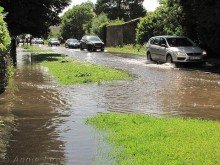With flood levels rising across Dorset, Poole Accident Repair is offering advice to motorists who are unable to avoid the roads.
Driving in floods and standing water can be extremely hazardous to people and property, yet research from the AA shows that more than half of UK drivers would risk endangering themselves and their vehicles by driving.
Moreover, a third of flood-related deaths involve a vehicle because drivers take unnecessary risks. In light of this, Poole Accident Repair, the South Coast’s leading prestige repairer has issued some advice for local motorists who insist on driving in floods and standing water.
Group Director of Accident Repair, Leon Coupland, says: “We do not recommend driving in floods and standing water at all if you can help it. However, we appreciate that it’s easy to get caught out during heavy downpours as even modern road surfaces are susceptible to standing water. This is a serious problem currently affecting our local area and we are issuing this advice to help Dorset’s residents be as safe as possible.”
- Never drive through water unless you knowfor a factthat it’s not too deep.
- Take it steady and adjust your speed to the conditions.
- Use a low gear so the engine’s revs are higher, otherwise water in the exhaust could damage the catalytic converter.
- Waves can be incredibly destructive so drive slowly and steadily to avoid creating them.
- If steering does become unresponsive, ease off the accelerator and slow down gradually.
- Test your brakes as soon as you can after leaving the water.
- Don’t ever attempt driving through fast-moving water, as your car could very easily be swept away.
- If you experience aquaplaning, hold the steering wheel lightly and ease off the accelerator until your tyres regain their grip with the road.
- Should you break down in heavy rain, keep the bonnet shut until help arrives as rain-soaked electrics can make it even more difficult to start your car.
A Few Facts From The AA…
A mere 60cm (two feet) of standing water can float a car, just 30cm (a foot) of flowing water is enough to move the average family car, it only takes 15cm (six inches) of fast flowing water to knock you off your feet and an eggcup full of water sucked into the engine can be enough to ruin it.
For more information, please visit: https://www.pooleaccidentrepair.co.uk/driving_in_floods







